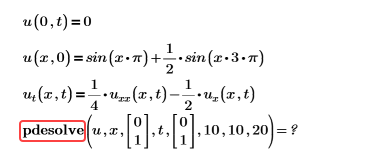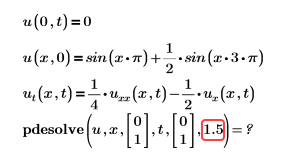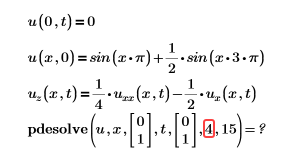Partial Differential Equations in Solve Blocks
pdesolve(u, x, xrange, t, trange, [xpts], [tpts]) - Returns a function or vector of functions u(x,t) that solves a one-dimensional nonlinear Partial Differential Equation (PDE) or system of PDEs, with n independent equality constraints for an nth order differential equation. Values are interpolated from a matrix of solution points calculated using the numerical method of lines.
You must use pdesolve in a Solve Block.
Arguments
• u is a scalar function name, or a vector of function name (with no variable names included) as they appear within the solve block. For example, if you are solving for the functions f(x,t) and g(x,t), u would be:

To accommodate the subscript partial differential notation, you cannot use Literal Subscripts when naming functions.
• x is the spatial variable name.
• xrange is a two-element column vector containing the real boundary values for x.
• t is the time variable name.
• trange is a two-element column vector containing the real boundary values for t.
• xpts (optional) is the integer number of spatial discretization points.
• tpts (optional) is the integer number of temporal discretization points.
The general rules of Defining a Solve Block apply. Within the body of the block:
Unknown functions
Functions must be defined in terms of their variables. For example, use u(x,t), not u. To indicate a partial derivative within the solve block, use one of the following:
• Subscript notation. For example, uxx(x,t) is the second partial derivative of u with respect to x.
Subscript notation can be used only in pdesolve in solve blocks, and not in other regions of the worksheet. |
• The partial derivative operator.
PDE Equations
Equations must be defined using Boolean Equals. Second partial derivatives are not allowed on the left-hand-side of equations, you must convert your equation to a system of equations in first derivatives only.
Boundary conditions
There must be an initial condition u(x,0), and n boundary conditions, where n is the order of the PDE, for each unknown function. Boundary conditions can be of type Dirichlet (u(0,t) = f(t)) or Neumann (ux(0,t)=g(t)), and can be specified at either endpoint of the spatial integration range. The endpoints used in boundary conditions must match the endpoints specified in the ode/pdesolve command. Mathcad checks for the correct type and number of constraints and flags mistakes with an error message.
Constraints
Algebraic constraints of the form u(x,t)+v(x,t)+w(x,t)=0 are allowed. This adds an extra unknown function w to the system, which must be specified as one of the output functions in the ode/pdesolve call. Inequality constraints are not allowed.
• Assign the output of the pdesolve function to a function name, or vector of function names.
• To change the approximation method used for the partial derivatives, right-click on the pdesolve function and choose another method. This may affect calculation time.
• The numerical method of lines is only appropriate for solving hyperbolic and parabolic PDEs, and partial algebraic equations. For solving an equation in a program loop, use numol. For solving an elliptic PDE, such as Poisson's equation, use Relax or Multigrid.
Following is a list of possible errors and solutions when working with pdesolve.
• Error: This function requires at least 5 arguments but is applied to 4.
Example:

Solution: Add a missing arguments, in this case it is trange.
• Error: This function accepts at most 7 arguments but is applied to 8.
Example:

Solution: Remove unnecessary arguments. See more information about arguments
• Error: Malformed vector of boundaries for time variable.
Example:

Solution: trange is not defined correctly. See more information in Arguments
• Error: Malformed vector of boundaries for space variable.
Example:

Solution: xrange is not defined correctly. See more information in Arguments
• Error: Unknown function name incorrectly specified.
Example:

Solution: The function must appear without an argument.
• Error: must be an integer greater than 4.
Example:

Or

Solution: The number of discretization points must be an integer greater than 4.